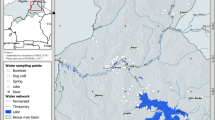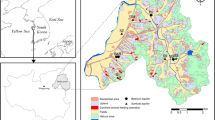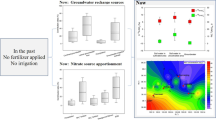Abstract
Identifying the magnitude and seasonal variability of groundwater nitrogen (N) under various land use types and quantifying the contribution of their environmental factors are of great importance when attempting to implement prioritizing effective strategies for mitigating groundwater N pollution. In this study, hydrochemical investigation was used to assess the magnitude and temporal variability of groundwater N in arid regions. Spatial distributions of N species (total N (TN), nitrate-N (NO3––N), ammonium-N (NH4+–N), and nitrous-N (NO2––N)) were mapped using geostatistical techniques. Redundancy analysis (RDA) was conducted to determine environmental factors controlling hydrochemistry. The results showed that residential areas (town and village) and cropland had higher groundwater N concentrations than natural (forest and grassland) and unused land. And the concentrations of N species in rain season (August) were greater than those in the dry season (March) and normal season (November). The N species spatial patterns showed that there is a risk of TN and NO3––N pollution in groundwater of town and surrounding developed cropland, and that NH4+–N and NO2––N pollution were negligible. Selected environmental factors explained a total of 77.4% of data variance in N concentrations. These factors indicated that water environmental factors (dissolved oxygen (DO), oxidation–reduction potential (ORP), water temperature (WT), and pH) affect groundwater concentrations and forms of N by influencing the process of nitrification and denitrification, which explained about 60% of the variance of the data. Approximately 10.8 and 8.3% of the variability was explained by shallow groundwater depth and soil texture, indicating that N concentrations in groundwater had heterogeneous influence. The high N excessive pollution ratio was observed in towns and cropland indicating that artificial N input is the main reason for groundwater N pollution in the study area. Hence, ameliorating anthropogenic agricultural practices and reducing N input in urban areas are critical to alleviating groundwater N pollution in the research area.






Similar content being viewed by others
References
Abdel-Satar AM, Al-Khabbas MH, Alahmad WR et al (2017) Quality assessment of groundwater and agricultural soil in Hail region, Saudi Arabia. Egypt J Aquat Res 43(1):55–64
Alabdulaaly AI, Alrehaili AM, Alzarah AI et al (2010) Assessment of nitrate concentration in groundwater in Saudi Arabia. Environ Monit Assess 161(1):1–9
Almasri MN, Kaluarachchi JJ (2004) Assessment and management of long-term nitrate pollution of ground water in agriculture-dominated watersheds. J Hydrol 295(1-4):225–245
Andrade A, Stigter TY (2009) Multi-method assessment of nitrate and pesticide contamination in shallow alluvial groundwater as a function of hydrogeological setting and land use. Agr Water Manage 96(12):1751–1765
Assouline S, Russo D, Silber A, Or D (2015) Balancing water scarcity and quality for sustainable irrigated agriculture. Water Resour Res 51(5):3419–3436
Bahrami M, Zarei AR, Rostami F et al (2020) Temporal and spatial assessment of groundwater contamination with nitrate by nitrate pollution index (NPI) and GIS (case study: Fasarud Plain, southern Iran). Environ Geochem Hlth:1–12
Böhlke JK, Smith RL, Miller DN (2006) Ammonium transport and reaction in contaminated groundwater: application of isotope tracers and isotope fractionation studies. Water Resour Res 42(5):1–19
Chai H, Xiang Y, Chen R, Shao Z, Gu L, Li L, He Q (2019) Enhanced simultaneous nitrification and denitrification in treating low carbon-to-nitrogen ratio wastewater: treatment performance and nitrogen removal pathway. Bioresour Technol 280:51–58
Chen A, Lei B, Hu W, Wang H, Zhai L, Mao Y, Fu B, Zhang D (2018) Temporal-spatial variations and influencing factors of nitrogen in the shallow groundwater of the nearshore vegetable field of Erhai Lake,China. sEnviron Sci Pollut R 25(5):4858–4870
El Alfy M, Lashin A, Abdalla F et al (2017) Assessing the hydrogeochemical processes affecting groundwater pollution in arid areas using an integration of geochemical equilibrium and multivariate statistical techniques. Environ Pollut 229:760–770
Fang J, Ding YJ (2010) Assessment of groundwater contamination by NO3− using geographical information system in the Zhangye Basin Northwest China. Environ Earth Sci 60(4):809–816
Feng L, Chen B, Hayat T et al (2017) The driving force of water footprint under the rapid urbanization process: a structural decomposition analysis for Zhangye city in China. J Clean Prod 163:5322–5328
Grimm NB, Foster DR, Groffman PM et al (2008) The changing landscape: ecosystem responses to urbanization and pollution across climatic and societal gradients. Front Ecol Environ 6(5):264–272
Gu B, Ge Y, Chang SX, Luo W, Chang J (2013) Nitrate in groundwater of China: sources and driving forces. Glob Environ Chang 23(5):1112–1121
Gu F, Huang M, Zhang Y (2016) Modeling the temporal-spatial patterns of atmospheric nitrogen deposition in China during 1961—2010. Acta Ecol Sin 36(12):3591–3600 (in Chinese)
Hammer DA, Knight RL (1994) Designing constructed wetlands for nitrogen removal. Water Sci Technol 29(4):15–27
Jia H, Qian H, Zheng L, Feng W, Wang H, Gao Y (2020) Alterations to groundwater chemistry due to modern water transfer for irrigation over decades. Sci Total Environ 717:137170
Jiao J, Zhou J, Yang W et al (2017) Spatiotemporal variability of different nitrogen forms in shallow groundwater of a small watershed in the sub-tropical region of China. Agro-Environ Sci 36(8):1573–1582 (in Chinese)
Kaushal SS, Groffman PM, Band LE, Elliott EM, Shields CA, Kendall C (2011) Tracking nonpoint source nitrogen pollution in human-impacted watersheds. Environ Sci Technol 45(19):8225–8232
Komarowski S, Yu Q (1997) Ammoniumion removal from wastewater Australian natural zeolite: batch equilibrium and kinetic studies. Environ Technol 18(11):1085–1097
Krupa M, Tate KW, Kessel C et al (2011) Water quality in rice-growing watersheds in a Mediterranean climate. Agric Ecosyst Environ 144(1):290–301
Lasagna M, De Luca DA, Franchino E (2016) Nitrate contamination of groundwater in the western Po Plain (Italy): the effects of groundwater and surface water interactions. Environ Earth Sci 75(3):240
Li J, He Z, Du J et al (2018) Regional variability of agriculturally-derived nitrate-nitrogen in shallow groundwater in China, 2004–2014. Sustainability 10(5):1393
Liu GD, Wu WL, Zhang J et al (2005) Regional differentiation of non-point source pollution of agriculture-derived nitrate nitrogen in groundwater in northern China. Agric Ecosyst Environ 107(2):211–220
Liu X, Zhang Y, Han W, Tang A, Shen J, Cui Z, Vitousek P, Erisman JW, Goulding K, Christie P, Fangmeier A, Zhang F (2013) Enhanced nitrogen deposition over China. Nature 494(7438):459–462
Liu X, Vidon P, Jacinthe PA, Fisher K, Baker M (2014) Seasonal and geomorphic controls on N and P removal in riparian zones of the US Midwest. Biogeochemistry 119(1):245–257
Liu B, Guan H, Zhao W, Yang Y, Li S (2017) Groundwater facilitated water-use efficiency along a gradient of groundwater depth in arid northwestern China. Agric For Meteorol 233:235–241
Ma Y, Liu ZH, Xi BD, He XS, Li QL, Qi YJ, Jin MY, Guo Y (2019) Characteristics of groundwater pollution in a vegetable cultivation area of typical facility agriculture in a developed city. Ecol Indic 105:709–716
Maltais-Landry G, Maranger R, Brisson J, Chazarenc F (2009) Nitrogen transformations and retention in planted and artificially aerated constructed wetlands. Water Res 43(2):535–545
Mi L, Xiao H, Zhang J, Yin Z, Shen Y (2016) Evolution of the groundwater system under the impacts of human activities in middle reaches of Heihe River Basin (Northwest China) from 1985 to 2013. Hydrogeol J 24(4):971–986
Moosavirad SM, Janardhana MR, Khairy H (2013) Impact of anthropogenic activities on the chemistry and quality of groundwater: a case study from a terrain near Zarand City, Kerman Province, SE Iran. Environ Earth Sci 69(7):2451–2467
Paredes I, Otero N, Soler A, Green AJ, Soto DX (2020) Agricultural and urban delivered nitrate pollution input to Mediterranean temporary freshwaters. Agric Ecosyst Environ 294:106859
Rozic M, Cerjan-stefanovic S (2000) Ammoniumcal nitrogen removal from water by treatment with clays and zeolites. Water Res 34(14):3675–3681
Schaefer K, Einax JW, Simeonov V, Tsakovski S (2010) Geostatistical and multivariate statistical analysis of heavily and manifoldly contaminated soil samples. Anal Bioanal Chem 396(7):2675–2683
Schot PP, Pieber SM (2012) Spatial and temporal variations in shallow wetland groundwater quality. J Hydrol 422:43–52
Serio F, Miglietta PP, Lamastra L, Ficocelli S, Intini F, de Leo F, de Donno A (2018) Groundwater nitrate contamination and agricultural land use: a grey water footprint perspective in Southern Apulia Region (Italy). Sci Total Environ 645:1425–1431
Sheng D, Wen X, Feng Q et al (2019) Groundwater nitrate pollution and human health risk assessment in the Zhangye Basin, Gansu China. J Desert Res 39(5):37–44 (in Chinese)
Simmelsgaard SE (1998) The effect of crop, N-level, soil type and drainage on nitrate leaching from Danish soil. Soil Use Manag 14(1):30–36
Su Y, Yang X, Yang R (2014) Effect of soil texture in unsaturated zone on soil nitrate accumulation and groundwater nitrate contamination in a marginal oasis in the middle of Heihe River basin. Environ Sci 35(10):3683–3691 in Chinese
Su Y, Zhang K, Liu T et al (2017) Changes in soil properties and accumulation of soil carbon after cultivation of desert sandy land in a marginal oasis in Hexi Corridor Region Northwest China. Sci Agric Sin 50(09):1646–1654 (in Chinese)
Sun Y, Deng S, Li D et al (2010) Spatial distribution and variability of main soil physical and chemical properties in Chongming and affecting factors. J Ecol Rural Environ 26(4):306–312 (in Chinese)
Wang Y, Li Y, Li Y, Liu F, Liu X, Gong D, Ma Q, Li W, Wu J (2015) Intensive rice agriculture deteriorates the quality of shallow groundwater in a typical agricultural catchment in subtropical central China. Environ Sci Pollut Res 22(17):13278–13290
Wang C, Yang P, Yu Y et al (2016) Spatial variability of nitrate nitrogen contamination in groundwater and its factors analysis in oasis area of Yanqi Basin. J Irrig Drain 35(04):65–70 (in Chinese)
Wen X, Wu J, Si J et al (2009) A GIS-based DRASTIC model for assessing shallow groundwater vulnerability in the Zhangye Basin, northwestern China. Environ Earth Sci 57(6):1435–1442
Wick K, Heumesser C, Schmid E (2012) Groundwater nitrate contamination: factors and indicators. J Environ Manag 111:178–186
Wu J, Sun Z (2016) Evaluation of shallow groundwater contamination and associated human health risk in an alluvial plain impacted by agricultural and industrial activities, mid-west China. Expos Heal Th 8(3):311–329
Yang R, Liu W (2010) Nitrate contamination of groundwater in an agroecosystem in Zhangye Oasis Northwest China. Environ Earth Sci 61(1):123–129
Yang R, Su Y, Kong J (2017) Effect of tillage, cropping, and mulching pattern on crop yield, soil C and N accumulation, and carbon footprint in a desert oasis farmland. Soil Sci Plant Nutr 63(6):599–606
Yen ST, Liu S, Kolpin DW (1996) Analysis of nitrate in near-surface aquifers in the midcontinental United States: an application of the Inverse Hyperbolic Sine Tobit Model. Water Resour Res 32(10):3003–3011
Zhang X, Xu Z, Sun X, Dong W, Ballantine D (2013) Nitrate in shallow groundwater in typical agricultural and forest ecosystems in China, 2004–2010. J Environ Sci-China 25(5):1007–1014
Zhang Q, Liu B, Zhang W et al (2015a) Assessing the regional spatio-temporal pattern of water stress: a case study in Zhangye City of China. Phys Chem Earth 79:20–28
Zhang S, Liu F, Xiao R, Li Y, Zhou J, Wu J (2015b) Emissions of NO and N2O in wetland microcosms for swine wastewater treatment. Environ Sci Pollut R 22(24):19933–19939
Zhang S, Xiao R, Liu F, Zhou J, Li H, Wu J (2016) Effect of vegetation on nitrogen removal and ammonia volatilization from wetland microcosms. Ecol Eng 97:363–369
Zhang Y, Zhao W, Fu L et al (2017) Soil macropore characteristics following conversion of native desert soils to irrigated croplands in a desert-oasis ecotone, Northwest China. Soil Tillage Res 168:176–186
Zhang Y, Zhao W, He J, Fu L (2018) Soil susceptibility to macropore flow across a desert-oasis ecotone of the Hexi Corridor Northwest China. Water Resour Res 54(2):1281–1294
Zhang Y, Zhao W, Ochsner TE et al (2019) Estimating deep drainage using deep soil moisture data under young irrigated cropland in a Desert-Oasis Ecotone, Northwest China. Vadose Zone J 18(1):180189
Zhangye City Ecological Environment Bureau (2018) Communiqué on Environmental Status of Zhangye City. Zhangye Statistical Publishing House, Beijing. http://www.zhangye.gov.cn/hbj/dzdt/tzgg/201906/t20190611_226220.html
Zhangye Statistics Bureau (2018). Zhangye Statistical Yearbook. Zhangye Statistical Publishing House, Beijing, 2000 http://www.zhangye.gov.cn/tjj/ztzl/tjsj/
Zhao W, Liu B, Zhang Z (2010) Water requirements of maize in the middle Heihe River basin, China. Agr Water Manage 97(2):215–223
Zhao S, Zhou N, Liu X (2016) Occurrence and controls on transport and transformation of nitrogen in riparian zones of Dongting Lake, China. Environ Sci Pollut Res 23(7):6483–6496
Zhou H, Zhi Zhao W (2019) Modeling soil water balance and irrigation strategies in a flood-irrigated wheat-maize rotation system. A case in dry climate, China. Agr Water Manage 221:286–302
Author information
Authors and Affiliations
Corresponding author
Additional information
Responsible Editor: Philippe Garrigues
Publisher’s note
Springer Nature remains neutral with regard to jurisdictional claims in published maps and institutional affiliations.
Rights and permissions
About this article
Cite this article
Wang, L., He, Z. & Li, J. Assessing the land use type and environment factors affecting groundwater nitrogen in an arid oasis in northwestern China. Environ Sci Pollut Res 27, 40061–40074 (2020). https://doi.org/10.1007/s11356-020-09745-6
Received:
Accepted:
Published:
Issue Date:
DOI: https://doi.org/10.1007/s11356-020-09745-6




